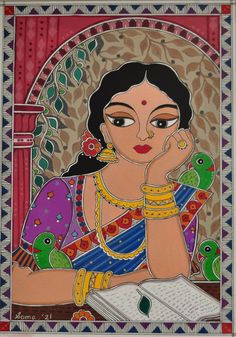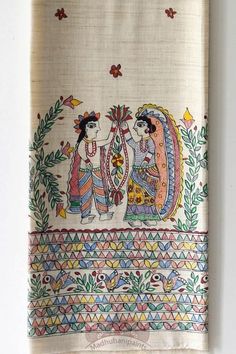Madhubani Saree Painting 03
Madhubani art, also known as Mithila painting, is a traditional art form that originates from the Mithila region of Bihar, India. Known for its vibrant colors, intricate patterns, and rich symbolism, Madhubani art has evolved over centuries, reflecting the cultural and social dynamics of the region. This class note delves into the history of Madhubani art, exploring its origins, evolution, techniques, themes, and contemporary relevance.
Origins of Madhubani Art
Ancient Roots

The origins of Madhubani art can be traced back to ancient times, with historical references suggesting that the art form was practiced as early as the 7th century BCE. It is believed that the tradition of painting in the Mithila region began as a ritualistic practice. Initially, the art was primarily confined to the walls of homes, especially during important life events like weddings and religious festivals. The paintings served both decorative and narrative purposes, often conveying stories of gods, goddesses, and natural elements.
Mythological Connections
Madhubani art is closely linked to Hindu mythology. One of the most prominent stories associated with this art form is the depiction of the wedding of Lord Rama and Sita. This mythological connection solidified the significance of Madhubani paintings in the cultural landscape of Mithila. The stories portrayed through this art form were not merely decorative; they were an integral part of the local beliefs and traditions.
Development Through the Ages
14th to 18th Century
By the 14th century, Madhubani painting began to flourish as a recognized art form. During this period, the art was predominantly practiced by women, who painted intricate designs on mud walls using natural dyes made from plants, flowers, and minerals. The use of symbolic motifs related to nature, fertility, and mythology became prevalent, reflecting the socio-cultural life of the Mithila region.
In the 18th century, the art gained attention from the royal courts, particularly under the patronage of the Maharajas of the region. This support allowed the art form to flourish, leading to the establishment of distinctive styles that reflected both local traditions and royal influences.
Colonial Influence and the Modern Era
The arrival of British colonialism in the 19th century brought significant changes to the socio-economic fabric of India, including the Mithila region. The economic constraints and shifts in patronage affected the traditional practice of Madhubani art. However, the 20th century saw a revival, spurred by the efforts of artists like Janak Singh and Sita Devi, who began to document and promote the art form.
In 1934, a devastating earthquake struck the Mithila region, leading to a loss of homes and livelihoods. This tragedy became a turning point for Madhubani art, as artists began to use their skills to earn a living by creating paintings on paper and cloth. The shift from wall paintings to canvas and textiles allowed Madhubani art to reach a broader audience.
Characteristics of Madhubani Art
Techniques and Materials

Madhubani art is characterized by its unique techniques and materials. Traditional artists used natural dyes derived from plants and minerals to create vibrant colors. The primary techniques include:
- Brush Painting: Fine brushes made from twigs or animal hair are used to create intricate patterns.
- Finger Painting: Some artists apply paint with their fingers, resulting in a distinctive texture.
- Stippling: Dots and lines are used to fill spaces, adding depth and complexity to the designs.
Themes and Motifs
The themes and motifs of Madhubani art are deeply symbolic. Common subjects include:
- Nature: Flowers, trees, birds, and animals often symbolize fertility, beauty, and the connection to the earth.
- Mythology: Stories of deities, particularly those from Hindu mythology, are frequently depicted, showcasing the spiritual beliefs of the region.
- Social Life: Scenes from daily life, such as weddings, rituals, and festivals, are common, providing a glimpse into the cultural practices of the community.
Styles of Madhubani Painting
Madhubani art comprises various styles, each with distinct characteristics:
- Bharni Style: Known for its vibrant colors and intricate patterns, often featuring religious themes.
- Kachni Style: Characterized by fine line work and monochromatic designs, focusing on detailed motifs.
- Godhana Style: This style incorporates bold colors and animal motifs, often used for storytelling.
- Tantrik Style: Deeply rooted in spiritual themes, this style includes intricate patterns and symbols representing various deities.
Contemporary Madhubani Art
Revival and Global Recognition
The late 20th century marked a significant revival of Madhubani art, with artists gaining recognition beyond regional boundaries. The art form began to attract attention in national and international exhibitions, leading to collaborations with designers and the incorporation of Madhubani motifs into contemporary fashion and home decor.
Empowerment of Artisans
Today, Madhubani art serves as a source of income for many artisans, especially women. Various initiatives and organizations work to empower these artists by providing training, resources, and platforms to sell their work. This empowerment not only supports the local economy but also helps preserve the traditional art form for future generations.
Educational Initiatives

Educational programs and workshops focusing on Madhubani art have emerged, allowing new generations to learn the techniques and cultural significance of this craft. These initiatives foster a deeper appreciation for the art form while promoting the skills required for its creation.
Conclusion
Madhubani art is a vibrant and dynamic expression of the cultural heritage of the Mithila region. Its rich history, rooted in ancient traditions and evolving through centuries, reflects the resilience and creativity of the communities that practice it. Today, as Madhubani art continues to gain recognition and relevance in contemporary society, it stands as a testament to the enduring power of art in preserving cultural identity and fostering community empowerment. By appreciating and supporting this unique art form, we contribute to the preservation of a valuable cultural legacy that enriches our collective human experience.